Summary
- Purchase two boneless or bone-in pork butts.
- Trim excess fat, if desired.
- Apply a generous coat of yellow mustard and your favorite rub.
- Cook at 225-250°F to an internal temperature of 190°F.
- Wrap in aluminum foil and hold in a cooler until ready to serve.
- Pull meat, sprinkle with extra rub, and serve with barbecue sauce on the side.
Mustard is a common ingredient in barbecue cooking, and it’s commonly “slathered” onto pork butt or ribs before the application of rub. Most people report that they cannot taste the mustard after cooking, so why use it in the first place? One reason is that mustard acts like glue to hold the rub on the meat. Another reason is that some people feel it promotes the formation of “bark”, the brown, chewy exterior layer of meat that is so flavorful.
I’m not sure if mustard makes for better bark, but I do know that lots of folks use it, that it’s fun to use, and I guarantee your pork butt won’t end up tasting like a hot dog!
This article was originally published in April 1999, and I’ve updated it based on a cooking session I did on April 17-18, 2004.
Buy And Prepare The Pork Butt
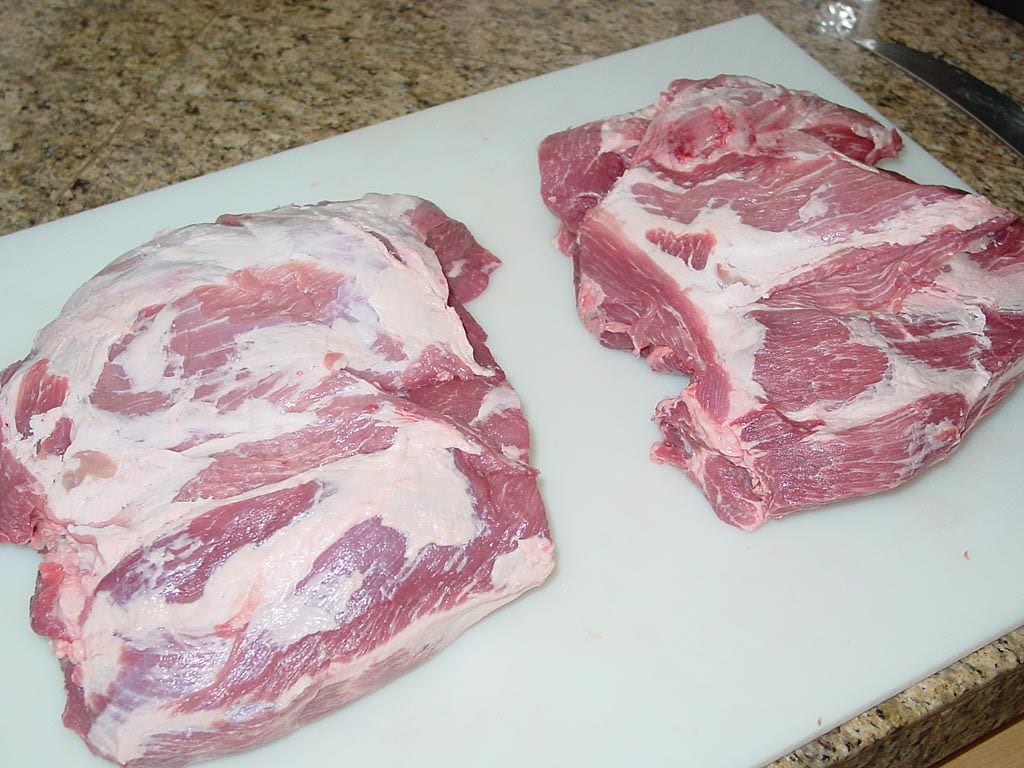
Purchase two large, untrimmed pork butts, either boneless or bone-in. Trim the excess fat as you see fit. If using boneless pork butts, consider tying each roast in three or four locations with kitchen twine to hold the meat together during cooking and handling.
Apply a generous coat of regular yellow mustard to all sides of the meat, then liberally sprinkle on your favorite rub. You can use a fancier mustard, if you like, but it won’t make a discernable difference to the flavor of the meat.
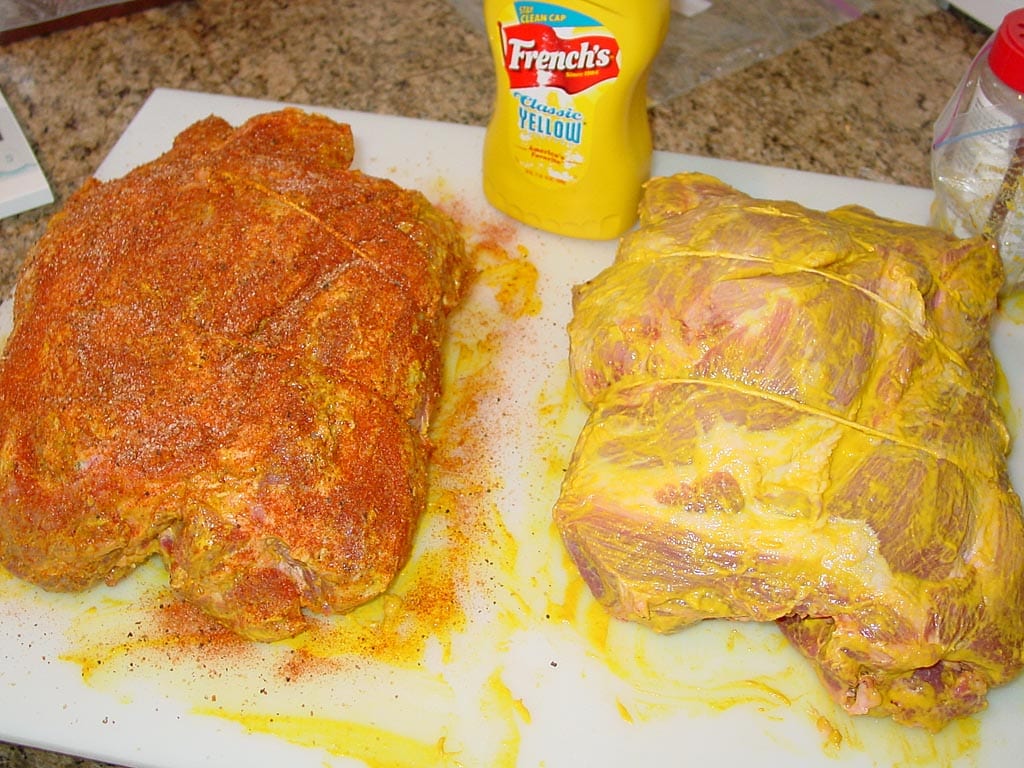
After applying the rub, let the butts sit at room temperature while firing up the cooker. Alternatively, you can refrigerate the meat for several hours or overnight.
I purchased a Cryovac package of two boneless pork butts from a wholesale warehouse store. One piece weighed 9 pounds, 10-1/2 ounces, the other 9 pounds, 11-1/4 ounces. I trimmed off the thick, exterior layer of fat from each butt and any large areas of fat that were easy to remove, then tied each butt with kitchen twine. After trimming, the butts weighed 7 pounds, 13 ounces and 7 pounds, 1 ounce respectively.
Here’s the rub recipe I used on these butts:
Modified Armadillo Willy’s Rub
- 1/4 cup brown sugar *
- 1/4 cup table salt
- 1/4 cup paprika
- 1 Tablespoon freshly ground black pepper
- 1 Tablespoon granulated garlic powder
- 1 Tablespoon onion powder
- 1-1/2 teaspoons cayenne pepper
- 1/2 teaspoon ground coriander
- 1/2 teaspoon fennel seed, crushed **
* I substituted Turbinado sugar (also known as “Sugar in the Raw”) for brown sugar.
** I omitted the crushed fennel seed as I don’t care for the flavor.
Mix ingredients thoroughly. Makes enough rub for two pork butts, with some leftover for sprinkling into pulled meat after cooking.
Fire The Cooker
Light the cooker using the Minion Method. Fill the charcoal ring to the top with unlit Kingsford Charcoal Briquets. Bury several chunks of dry smoke wood in the coals and place a few chunks of wood on top. Unless you’re cooking in extremely cold or windy conditions, this should be enough fuel to fire the cooker for 18 hours or more.
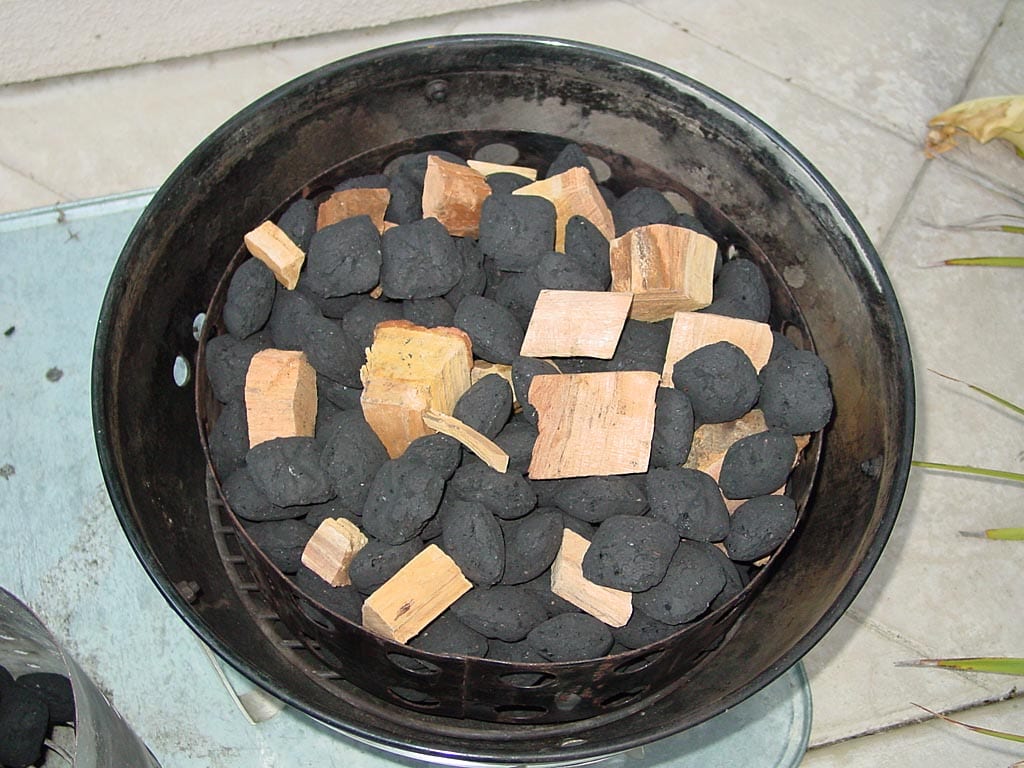
Light about 20 briquettes in a Weber chimney starter and spread them over the unlit briquettes and smoke wood chunks.
Assemble the cooker and fill the water pan with hot tap water. Put the butts into the cooker, one on each cooking grate (or both on the same grate, if they fit). If the butts are of different sizes, put the larger butt on the top grate and the smaller one on the bottom.
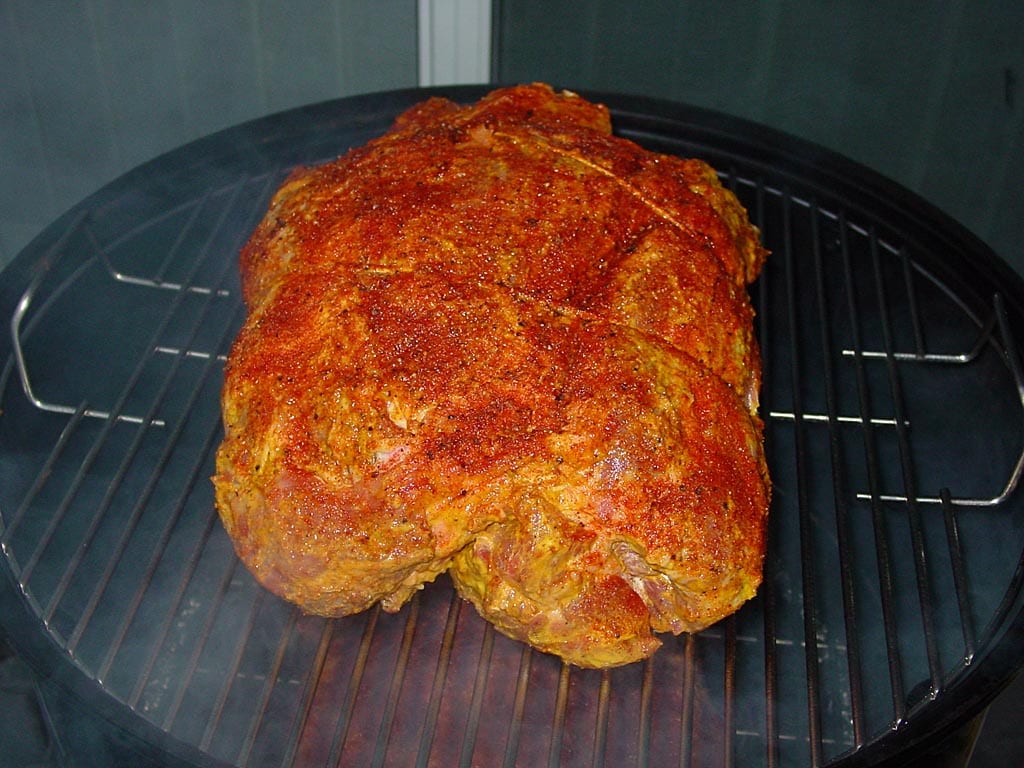
Set the top vent 100% open and leave it that way throughout the entire cooking session. Start with all three bottom vents 100% open. When the cooker temperature hits 200°F measured at the lid, set the three vents to 25% open. Allow the cooker to come up to 225-250°F, adjusting the bottom vents as necessary to maintain that temperature range.
For this cook, I used apple smoke wood. I didn’t have any large chunks, so I used lots of smaller pieces equivalent to about four fist-sized pieces.
I also lined just the outside surface of the pan with heavy-duty aluminum foil for easy cleanup.
Smoke The Meat
Cook the butts at 225-250°F to an internal temperature of 190°F. Turn the meat at least once after 9-12 hours of cooking, and baste several times after 9-12 hours of cooking.
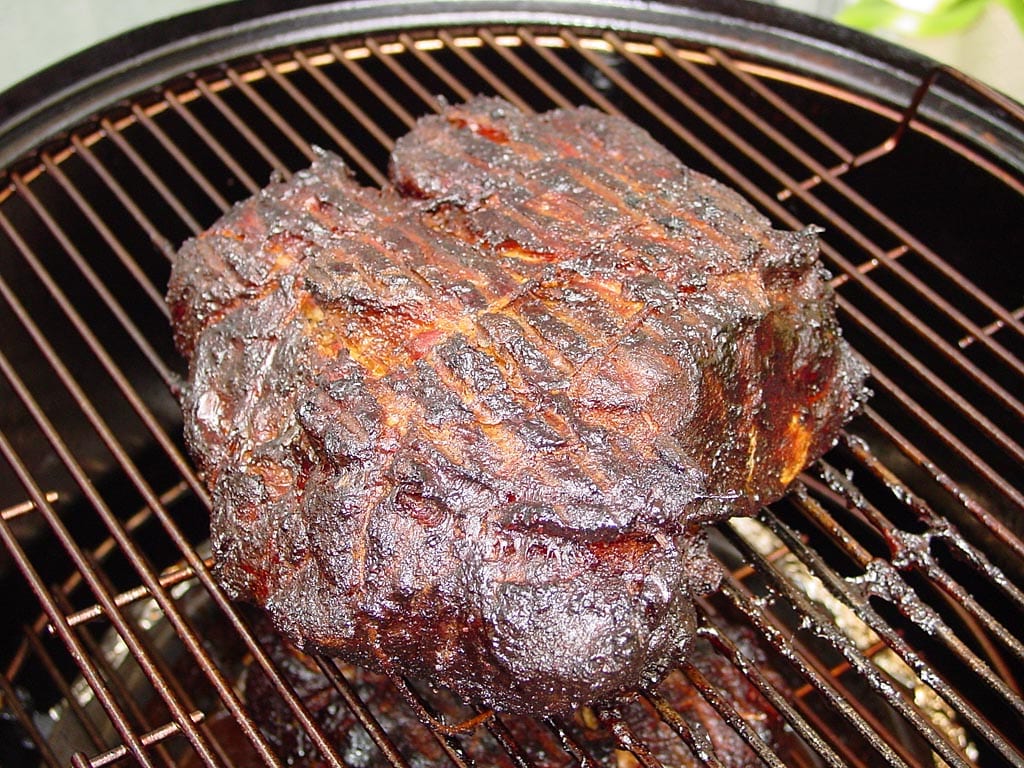
I turned these butts only once after 12 hours of cooking, and basted three times after turning the meat using this solution:
Pork Baste
- 1/2 cup apple juice
- 1/4 cup apple cider vinegar
- 1/4 cup vegetable oil
Place ingredients in a spray bottle and shake well to combine before each application.
Replenish the water pan with hot tap water as necessary.
Monitor the internal temperature of each butt using an instant-read thermometer or a probe thermometer. Since a pork butt is comprised of several different muscles, it may give different readings when probed in different locations. As a result, it’s best to check in several spots and average the results to determine the internal temperature of the meat.
I cooked these two butts overnight starting at 7:45pm and ending at 1:30pm. I started checking internal temperature after 14 hours of cooking.
Here’s how the cooker temperature and vent settings went during this almost 19 hour cooking session:
| Time | Lid Temp | Meat Temp | Vent 1 % | Vent 2 % | Vent 3 % |
| 7:45 pm | – | – | 100 | 100 | 100 |
| 8:00 pm | 167 | – | 100 | 100 | 100 |
| 8:15 pm | 200 | – | 25 | 25 | 25 |
| 8:45 pm | 205 | – | 25 | 25 | 25 |
| 9:15 pm | 215 | – | 25 | 25 | 25 |
| 10:30 pm | 230 | – | 25 | 25 | 25 |
| 11:30 pm | 244 | – | 25 | 25 | 25 |
| 12:30 am | 244 | – | 25 | 25 | 25 |
| 2:00 am | 250 | – | 25 | 25 | 25 |
| 7:45 am (s)(t) | 180 | – | 25 | 25 | 25 |
| 8:00 am | 234 | – | 25 | 25 | 25 |
| 9:00 am (s)(b) | 210 | – | 25 | 25 | 25 |
| 10:00 am (b) | 255 | 160-170 | 25 | 25 | 25 |
| 11:00 am (b) | 251 | – | 25 | 25 | 25 |
| 12:00 pm | 235 | 175-185 | 100 | 100 | 100 |
| 1:30 pm | 249 | 188-193 | 100 | 100 | 100 |
(s) stirred coals
(t) turned meat over and end-for-end
(b) basted meat
Note that the vent percentages represent the way I set the vents at the time indicated.
Hold The Meat For Serving
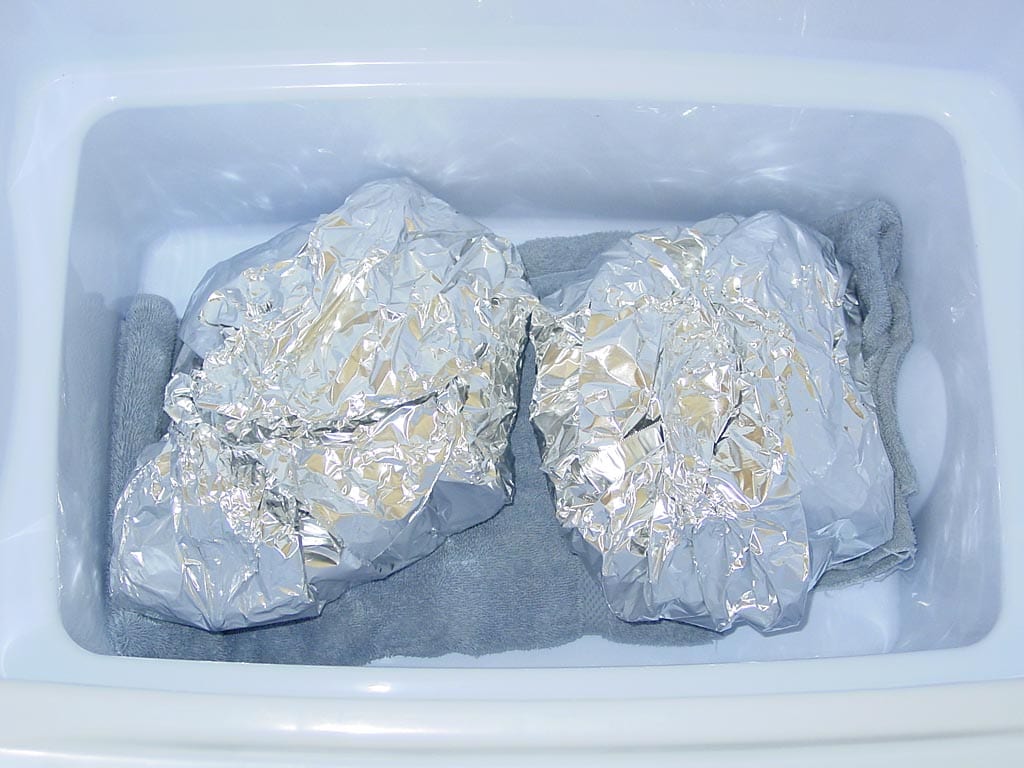
When the meat reaches 190°F, remove from the cooker and wrap tightly with heavy-duty aluminum foil. Place the wrapped butts in an empty cooler and hold until ready to pull and serve. The meat will remain safely above 140°F for 2-4 hours. See Holding, Storing & Reheating Barbecued Meats for more details.
Pull The Pork & Serve
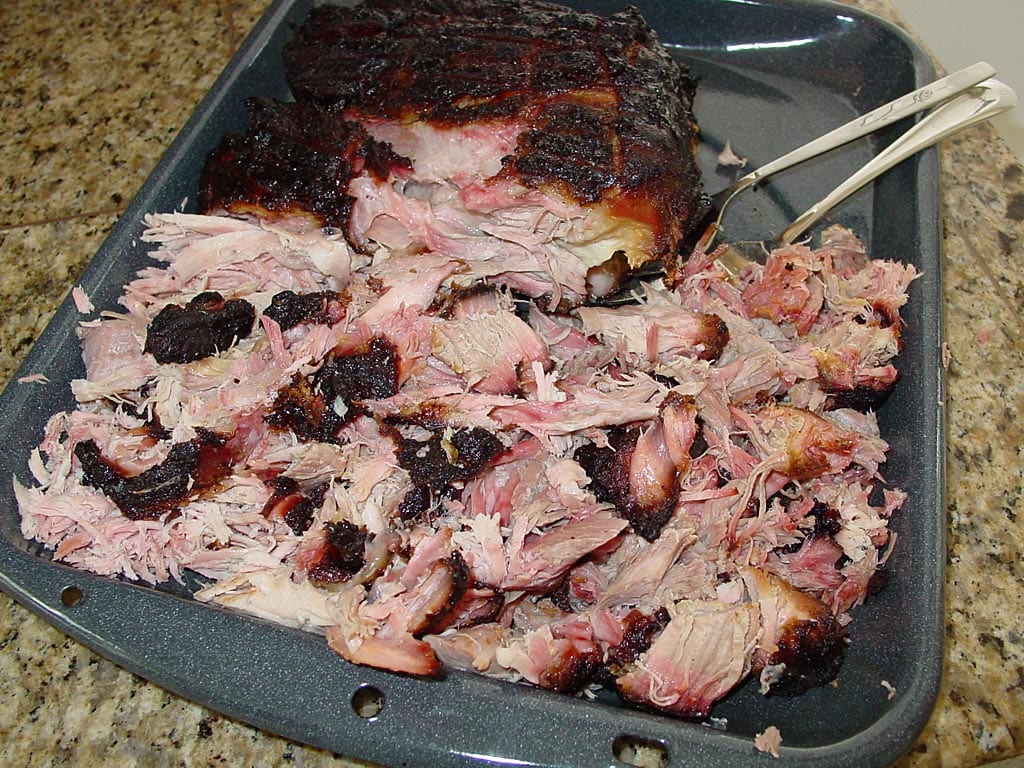
Use heat-resistant gloves or two large serving forks to shred the pork into bite-sized pieces. Remove pockets of fat or anything else that does not look appetizing.
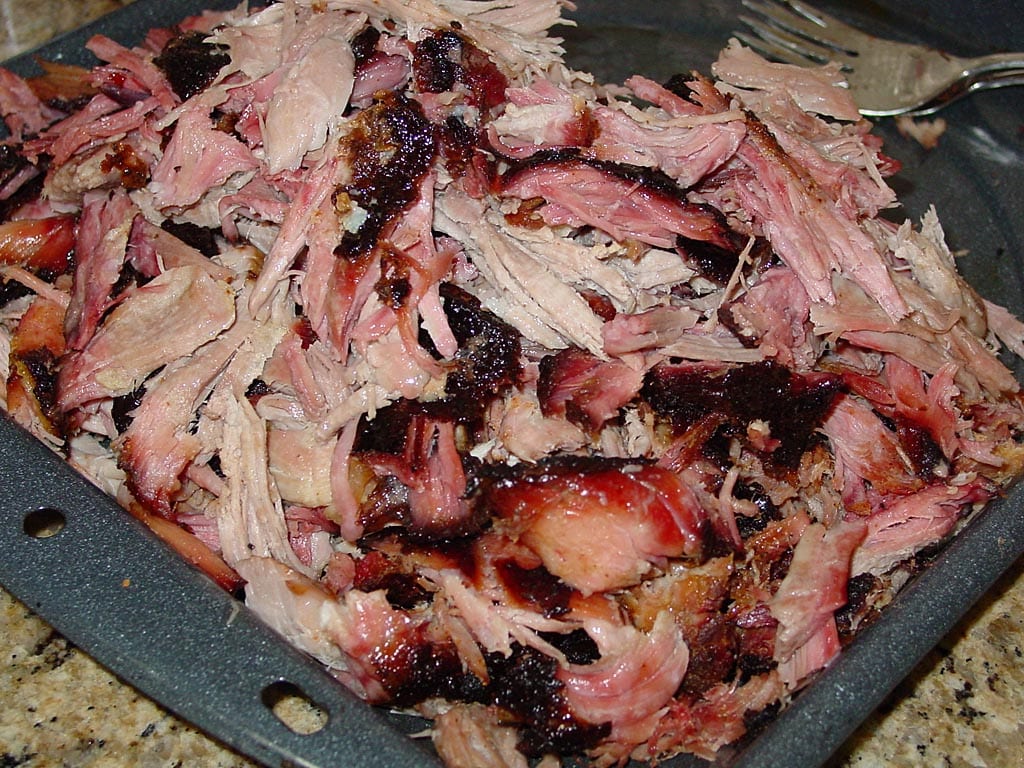
Season the pulled meat with leftover rub to taste, mixing thoroughly. You can even stir in a bit of thinned barbecue sauce. Make sure the dark, outside pieces of “bark” are distributed throughout the mix. Serve with your favorite barbecue sauce on the side.
These photos show pork sliders made from pulled pork. Mix warm barbecue sauce into the meat and place on little hamburger buns or rolls.
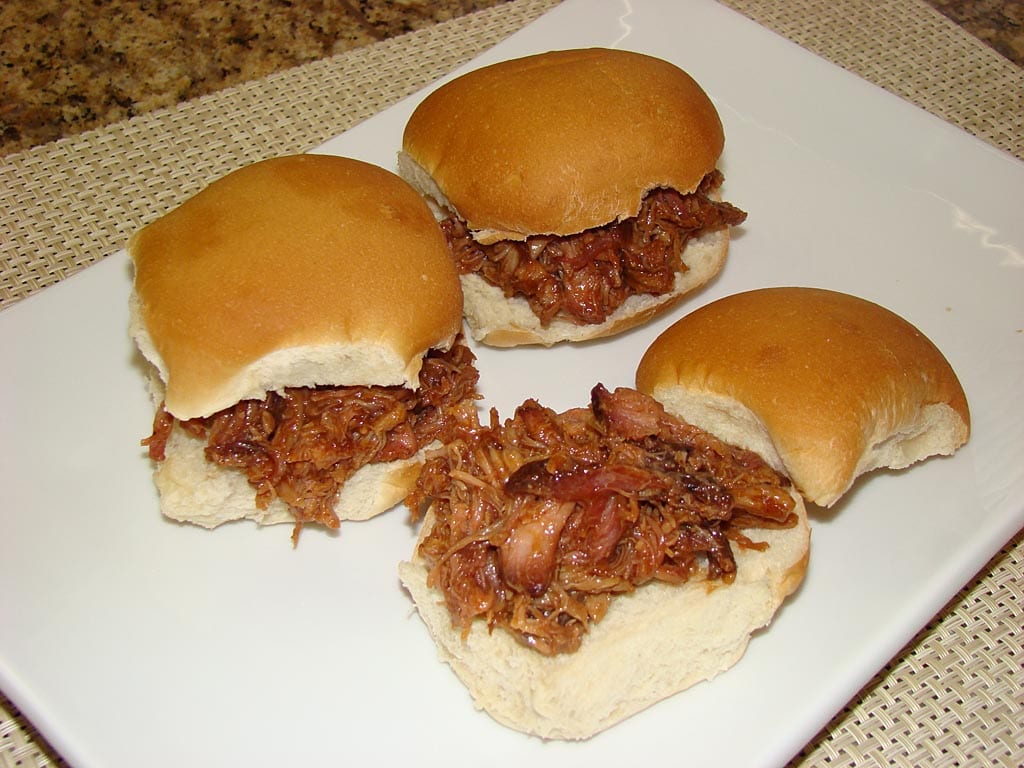
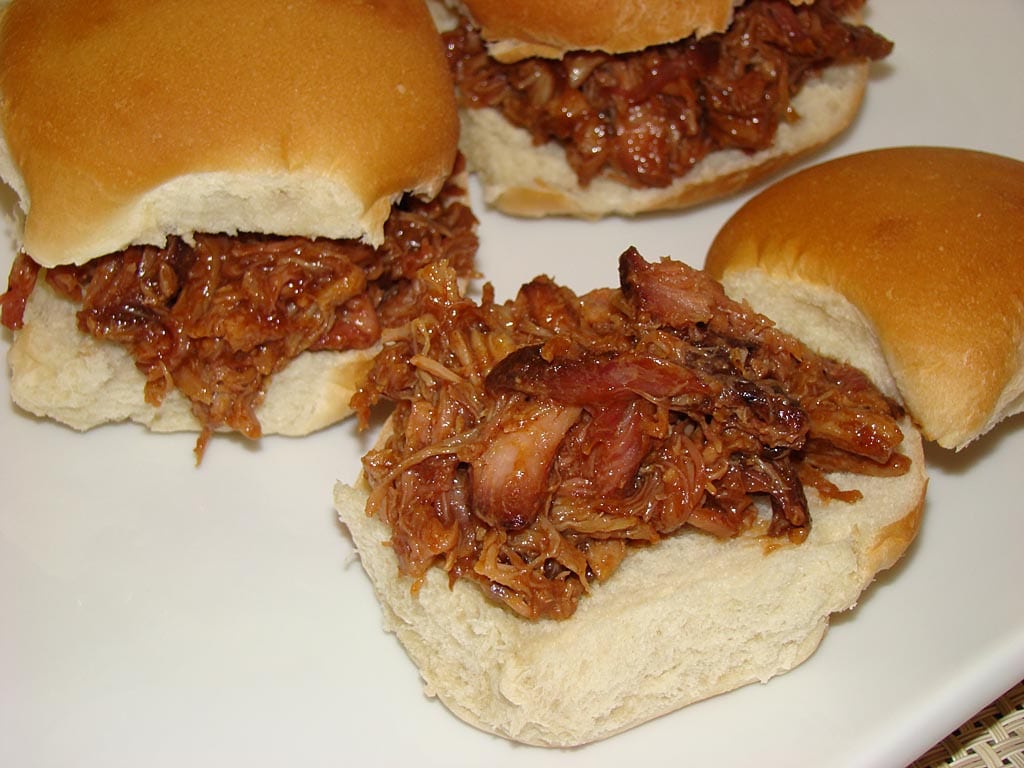
I recorded these results in my cooking log:
- Dark, crusty exterior
- Very good smoke ring
- Very tender, pulled easily
- Good moisture
- Flavorful bark
- One of the easiest cooks ever!
More Pork Butt Links On TVWB
- Pork Butt – Smoke & Spice The Renowned Mr. Brown
- Pork Butt – Chris Lilly Big Bob Gibson Championship Injection
- Pork Butt – Harry Soo Slap Yo’ Daddy Injection
- Pork Butt – Untrimmed Direct Heat
- Pork Butt – Buckboard Bacon
- Pork Butts In Foil Pans
- Pulled Pork Butt Servings Calculator
- Pork Butt Selection & Preparation
 Consider The Pig
Consider The Pig
Take a moment to reflect on the pig…
Think of all the good eatin’ we get out of a pig. Like the pork shoulder—Boston butt, blade steak, arm picnic, arm roast, arm steak, and ground pork. Ribs—spares, baby backs, and country-style, too. Chops—sirloin, rib, loin, and top loin. Tenderloin. Roasts—top loin, center loin, and sirloin. Ham—whole, butt-end, shank-end, center slices, and boneless. And don’t forget pork belly…my mouth waters just thinkin’ about bacon.
Some folks pickle the feet, cook up the snoots, deep-fry the skin, and make chitterlings out of the small intestines. About the only part we don’t use for food, footballs, or chew toys is the tail…or does that go into hot dogs?
God bless the pig—it’s truly “The Magical Animal”.






